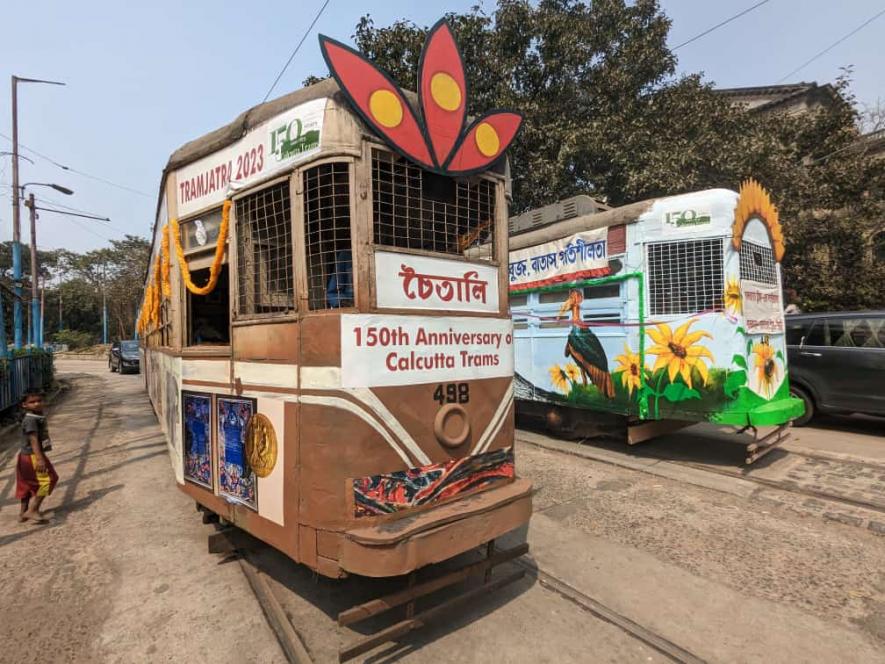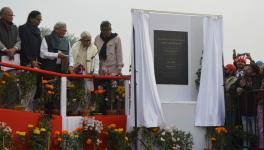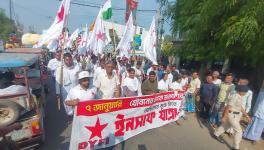Kolkata Tramways Observes 150th Year While Facing Extinction Under TMC Govt

Kolkata: The Calcutta Tramways Company (CTC), the only tramways utility service provider in the country, is now facing extinction. During the change of governance in the state in 2011, the CTC operated on 37 routes. Now, after 12 years of the Trinamool Congress reign, the company operates on only two routes without any plans for revival.
The CTC on Tuesday observed its 150th year amidst protests by the Opposition against the government’s plan to withdraw the tram services. Protests organised by CPI(M) Kolkata district committee were held before all the tram depots in the city. At the protests, it was decided to take the movement forward to properly run the tram services in Kolkata.
During the celebrations of the 150th birth anniversary of Kolkata’s trams, West Bengal transport minister Snehasis Chakraborty was invited by the Calcutta Tram Users Association (CTUA), a group formed by people advocating for more tram services. Chakraborty said trams would run on “four or five routes” and “it would not be possible” to run them on all routes like before. He added that trams would remain a heritage of the city.
On February 23, 1873, the colonial Britishers first introduced horse-driven tramcars to cater to the passenger transportation section in Kolkata.
At the protest on the occasion, Communist Party of India (Marxist [CPI(M)] state committee member Sudip Sengupta said that tram services are active in over 450 cities and many cities that had earlier withdrawn tram routes have now re-introduced them because of its eco-friendliness.
In contrast, the Mamata Banerjee government is withdrawing tram routes and facilitating sale of the tram depot lands in prime locations of the city. “Already about 300 cottas of land in Tollygunge and other tram depots has been sold off to real estate promoters,” Sengupta said .
Speaking to NewsClick, Debasish Bhattacharya, President of Kolkata Tram Users Forum, said the present government has no plans for running the tramways in the city. According to him, the present transport minister is not interested in augmenting the services of Kolkata tramways, which is often referred to as the pride of the city. “The government was not very keen to celebrate the 150th year anniversary of Kolkata tramways, but we participated in the programme in a big way to make it successful,” Bhattacharya said.
Even though Asia’s only electric tramway is in operation in Kolkata, the number of passengers, daily revenue and staff have dwindled over time.
“At 9 am, we entered our jail premises (workshops without any work), and until 5 pm, our torture continued as we sat there idly without any work,” said Subir Basu, a retired employee of the West Bengal Transport Corporation (WBTC), which runs the tramways.
The WBTC employees have made renovated, modern, and lightweight trams with fibre bodies and transparent roofs to attune them to the present times as the rolling stocks ran on Kolkata roads.
The tram service used to be well-networked and extensive, while the low fares provided an affordable ride for the common people. Many argue that the trams could offer a sustainable solution to the city’s growing traffic and shrinking road space while also being an alternative to vehicles running on fossil fuel. However, with dedicated tramlines being used up by moving traffic and the lack of proactive government support, the tram services have been reduced to being a token part of Kolkata’s heritage.
Now, one by one, the tram depots and workshop lands are being handed over to private entities. Over Rs 300 crores of funds generated from the sale of assets of the tramways have been transferred to the government while the century-plus organisation still suffers from a funds crunch.
CPI(M) veteran Rajdeo Goala was a tramways worker around the time of India’s Independence and was later elevated to the corporation’s chairman position. He had alleged before his death that there was a conspiracy to sell the WBTC as a heritage entity or dismantle it by suppressing the workers.
According to Subir Basu and his fellow worker in WBTC, Tapas Adhikary, the golden period of Calcutta Tramways was between 1978 and 1987. In 1977-78, when the Left Front had just assumed power in the state, MD Amin, the then Minister of Transport, had ordered 159 Burn and Jessop standard-body tram cars and invested Rs 43 crores for the betterment of tram services across the city, they told NewsClick.
The tramways had been at the centre of transportation in the city until the “neo-liberal regime” set in the country, recounted Basu. He said that in 1993, within one night, the planned support of the Indian government to CTC was withdrawn, paving the way for a huge crisis in the Calcutta Tramways.
When the British owners withdrew from the CTC (later dissolved and taken over by WBTC), there were 13,500 employees in the company. In 1977-78, there were 7,500 employees. Then in the 90s, the total tramline in the city ran for 74 kilometres, and 472 holding cars (cars in the hand of the company) were in operation, of which 385 were in en route condition.
Amidst this situation, on November 4, 1992, bus services were introduced under the CTC with thousands of new recruitments. The next improvement for the tramways came in 2009 when the new single-body trams were introduced, and tramlines were planned to be extended to Rajarhat in North 24 Parganas.
After the change in regime in West Bengal in 2011, the Calcutta Tramways faced its biggest crisis as, within a single night, the Dharmatolla-Joka route was discontinued by the Trinamool Congress-led government. The wages of 278 workers recruited as permanent employees in 2008-2011 were stopped, even leading to suicides by two affected employees. With new recruitments closed, there were 7,300 regular employees and 272 casual employees in the WBTC in 2011. Currently, it has come down to 2,400 permanent and 272 casual employees, while jobs are being outsourced to other companies.
Right now, in the WBTC, there are 253 tramcars in operation, out of which 103 are in running condition, while roughly 25 cars run on the routes daily. At present, the tramway operates on only two routes with all others closed for usage. In 2011, the tramcars used to run on 25-28 routes. “Tram is now being changed to just a token transportation system,” rued Bose.
In 2011, there were 62 km of serviceable lines apart from depot land, which has been reduced to only 17 km of line spread across three routes. Earlier, on the 62 km route, 225 tram cars used to run, while now, 25 cars are running on the 17 km route. The number of passengers decreased from more than 1 lakh in 2011 to only around 8,000 passengers per day on the reduced route.
The discussion on closing down the tramways has gained momentum again, while earlier rounds of such talks were thwarted by the positive public image the tramways carry as an eco-friendly mode of transport.
Meanwhile, Kolkata Bus-o-pedia regularly conducts joyrides on the trams, clicking pictures and taking signatures from passengers and urges the government not to close the century-old heritage entity.
Get the latest reports & analysis with people's perspective on Protests, movements & deep analytical videos, discussions of the current affairs in your Telegram app. Subscribe to NewsClick's Telegram channel & get Real-Time updates on stories, as they get published on our website.
























